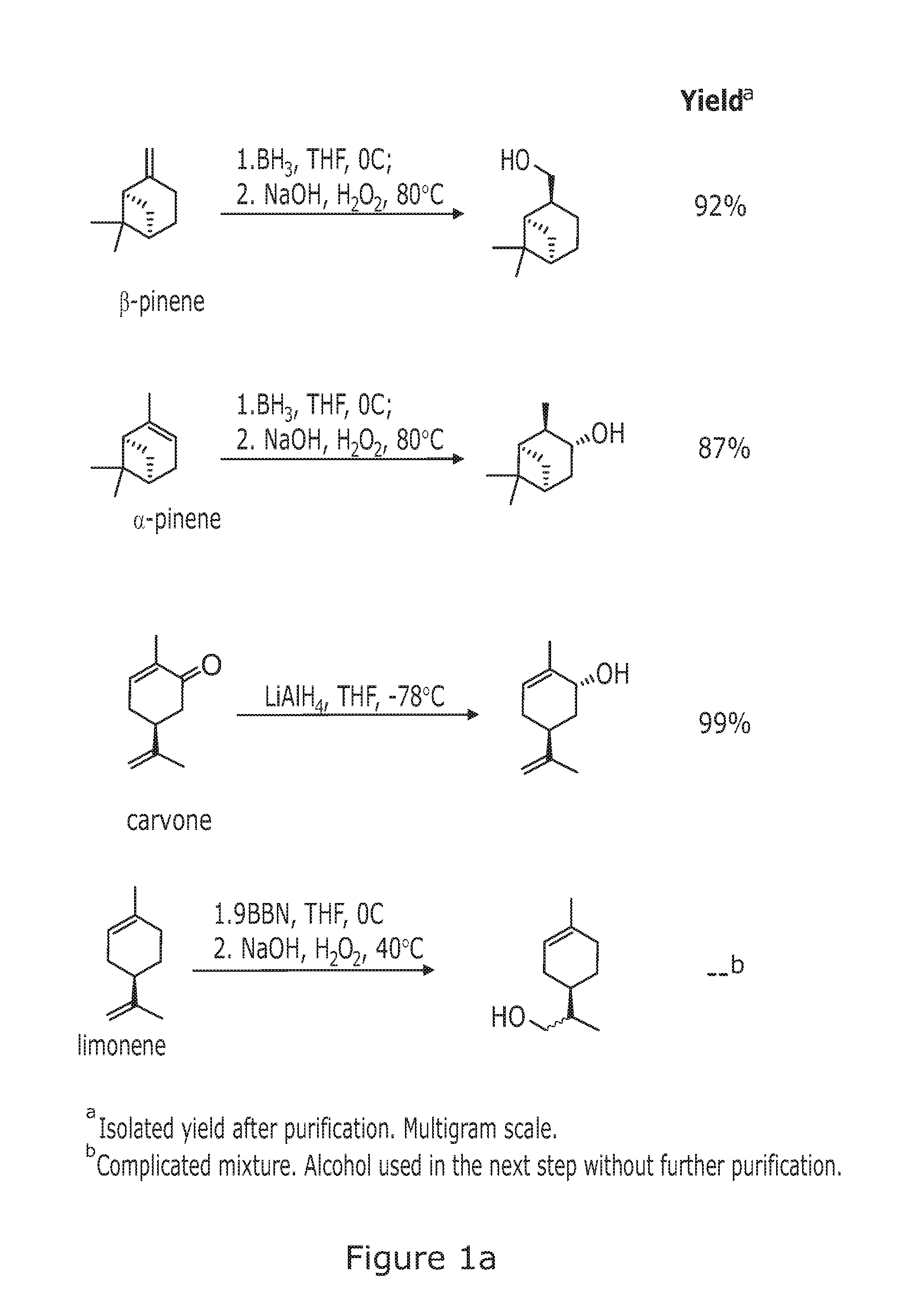Terpene and terpenoid derivatives containing vinyl groups for the preparation of polymers
a technology which is applied in the field of terpenes and terpenoids derivatives containing vinyl groups for the preparation of polymers, can solve the problems of low economic viability, low efficiency, and low cost of renewable polymers, and achieves good thermomechanical stability of bio-derived polymers, easy to polymerise, and good thermomechanical stability
- Summary
- Abstract
- Description
- Claims
- Application Information
AI Technical Summary
Benefits of technology
Problems solved by technology
Method used
Image
Examples
example 1
Formation of Functionalised Terpenes and Terpenoids
General Methods
Experimental Procedures
[0307]Unless otherwise stated, reagents were purchased from commercial sources and used without further purification. All reactions were carried out in flame-dried glassware under Ar atmosphere. THF was distilled from Na / benzophenone immediately prior to use. DCM was dried over 4 Å molecular sieves prior to use. Methyl-tetrahydrofuran was purchased from Aldrich over 4 Å molecular sieves. Column chromatography was carried out either manually on silica gel Fluka 60 or on a Biotage® SP4 using Biotage® SNAP KP-Sil cartridges and petroleum ether (40-60° C.) / ethyl acetate as eluent, whilst monitoring by UV (254 nm) and thin layer chromatography (PMA stain). All NMR spectra were obtained in CDCl3 at room temperature using Bruker® DPX300, Bruker® AV400 spectrometers for which chemical shifts are expressed in ppm relative to the solvent and coupling constants are expressed in Hz. Infrared spectroscopic d...
example 1a
Production of Functionalised Monomers
((1R,2S,5R)-6,6-Dimethylbicyclo[3.1.1]heptan-2-yl)methanol
[0312]
[0313]General method 1a was used.
[0314]Reagents and amounts used:[0315]β-pinene (24 mL, 148 mmol)[0316]Solvent and borating agent system: THF (56 mL), BH3*SMe2 (74 mL, 148 mmol, 2M in THF)[0317]Solvent and oxidising agent system: EtOH (72 mL), NaOH (80 mL, 1M in H2O),[0318]H2O2 (36 mL, 30% v / v in H2O)
[0319]Product obtained: 23.5 g (99% yield) of ((1R,2S,5R)-6,6-dimethylbicyclo[3.1.1]heptan-2-yl)methanol as a colorless oil that becomes solid after storing at low temperature.
[0320]Stereochemical assignment (based on literature precedent—G G. Giacomelli, L. Lardicci, F. Palla J. Org. Chem. 1984, 49, 310)
[0321][α]D22 −20 (c 4.9, CHCl3). 1H-NMR (400 MHz, CDCl3): δ=3.6-3.5 (m, 2H), 2.4-2.3 (m, 2H), 2.3-2.2 (m, 1H), 2.0-1.9 (m, 1H), 1.9-1.8 (m, 4H), 1.5-1.4 (m, 1H), 1.15 (s, 3H), 0.94 (s, 3H), 0.93 (d, J=9.6 Hz, 1H). 13C-NMR (100 MHz, CDCl3): δ=67.6 (t), 44.3 (d), 42.8 (d), 41.4 (d), 38.5 (...
example 1b
[0426]An alternative to the esterification process of general method 2 above was tested, to form acrylate and methacrylate derivatives. Specifically, the hydroxylated compounds were acrylated by treatment with the acrylic acid and T3P® as coupling agent, with Et3N as a base.
[0427]Table 3 shows the results for pinene alcohols with T3P®. Yields were improved as compared to general method 2 and the need for silica gel chromatography was avoided.
TABLE 3T3PYield / Starting materialScale(equiv.)SolventProductpurification100 mg1.5CH2Cl299% Aq. work-up100 mg1.5CH2Cl299% Aq. work-up
[0428]The synthesis of the monomers was also carried out using this alternative process but using the environmentally friendly MeTHF as solvent, instead of CH2Cl2. The yields are set out in Table 4.
TABLE 4Starting materialAcryloyl chlorideMethacryloyl chloride61% 52% (45g scale)33%62%52% (30 g scale)91% (50 g scale)92% (50 g scale)
PUM
 Login to View More
Login to View More Abstract
Description
Claims
Application Information
 Login to View More
Login to View More - R&D
- Intellectual Property
- Life Sciences
- Materials
- Tech Scout
- Unparalleled Data Quality
- Higher Quality Content
- 60% Fewer Hallucinations
Browse by: Latest US Patents, China's latest patents, Technical Efficacy Thesaurus, Application Domain, Technology Topic, Popular Technical Reports.
© 2025 PatSnap. All rights reserved.Legal|Privacy policy|Modern Slavery Act Transparency Statement|Sitemap|About US| Contact US: help@patsnap.com



